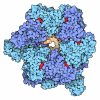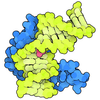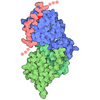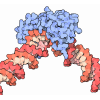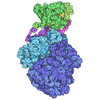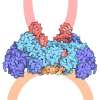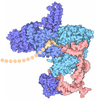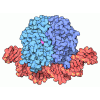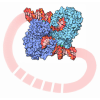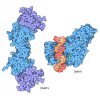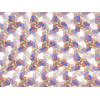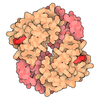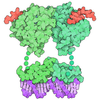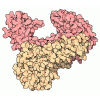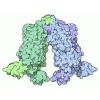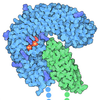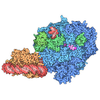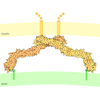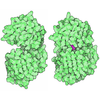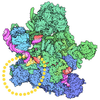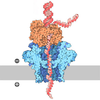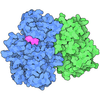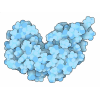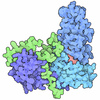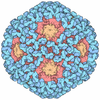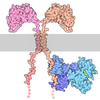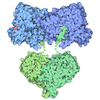+ Open data
Open data
- Basic information
Basic information
| Entry | Database: PDB / ID: 7plo | ||||||||||||
|---|---|---|---|---|---|---|---|---|---|---|---|---|---|
| Title | H. sapiens replisome-CUL2/LRR1 complex | ||||||||||||
 Components Components |
| ||||||||||||
 Keywords Keywords | REPLICATION / Genome stability / DNA replication / Ubiquitination / termination / replisome / cryo-EM / CMG / Cul2LRR1 / DNA / polymerase / helicase | ||||||||||||
| Function / homology |  Function and homology information Function and homology informationcellular response to bleomycin / DNA secondary structure binding / detection of abiotic stimulus / regulation of nuclear cell cycle DNA replication / replication fork arrest / Switching of origins to a post-replicative state / cell cycle phase transition / Unwinding of DNA / DNA replication initiation / epsilon DNA polymerase complex ...cellular response to bleomycin / DNA secondary structure binding / detection of abiotic stimulus / regulation of nuclear cell cycle DNA replication / replication fork arrest / Switching of origins to a post-replicative state / cell cycle phase transition / Unwinding of DNA / DNA replication initiation / epsilon DNA polymerase complex / DNA strand elongation involved in mitotic DNA replication / GINS complex / mitotic DNA replication preinitiation complex assembly / activation of protein kinase activity / cellular response to cisplatin / replication fork protection complex / nuclear origin of replication recognition complex / cellular response to hydroxyurea / anaphase-promoting complex binding / Regulation of MITF-M-dependent genes involved in DNA replication, damage repair and senescence / alpha DNA polymerase:primase complex / nucleotide-excision repair, DNA gap filling / cullin-RING-type E3 NEDD8 transferase / NEDD8 transferase activity / mitotic DNA replication / DNA replication checkpoint signaling / cullin-RING ubiquitin ligase complex / regulation of phosphorylation / CMG complex / DNA replication proofreading / cellular response to chemical stress / Cul7-RING ubiquitin ligase complex / ubiquitin-dependent protein catabolic process via the C-end degron rule pathway / DNA replication preinitiation complex / single-stranded DNA 3'-5' DNA exonuclease activity / MCM complex / Loss of Function of FBXW7 in Cancer and NOTCH1 Signaling / target-directed miRNA degradation / elongin complex / mitotic DNA replication checkpoint signaling / double-strand break repair via break-induced replication / positive regulation of protein autoubiquitination / RNA polymerase II transcription initiation surveillance / protein neddylation / mitotic DNA replication initiation / NEDD8 ligase activity / mitotic intra-S DNA damage checkpoint signaling / VCB complex / negative regulation of response to oxidative stress / Cul5-RING ubiquitin ligase complex / Hydrolases; Acting on ester bonds; Exodeoxyribonucleases producing 5'-phosphomonoesters / regulation of DNA-templated DNA replication initiation / inner cell mass cell proliferation / SCF ubiquitin ligase complex / Cul2-RING ubiquitin ligase complex / negative regulation of type I interferon production / ubiquitin-ubiquitin ligase activity / SCF-dependent proteasomal ubiquitin-dependent protein catabolic process / Cul4A-RING E3 ubiquitin ligase complex / Cul4-RING E3 ubiquitin ligase complex / Cul3-RING ubiquitin ligase complex / DNA strand elongation involved in DNA replication / Apoptotic cleavage of cellular proteins / Cul4B-RING E3 ubiquitin ligase complex / DNA synthesis involved in DNA repair / branching morphogenesis of an epithelial tube / ubiquitin ligase complex scaffold activity / positive regulation of double-strand break repair / negative regulation of mitophagy / Prolactin receptor signaling / leading strand elongation / G1/S-Specific Transcription / mitotic G2 DNA damage checkpoint signaling / nuclear replication fork / replication fork processing / cullin family protein binding / DNA replication origin binding / Pausing and recovery of Tat-mediated HIV elongation / Tat-mediated HIV elongation arrest and recovery / cochlea development / HIV elongation arrest and recovery / Pausing and recovery of HIV elongation / PCNA-Dependent Long Patch Base Excision Repair / DNA replication initiation / Activation of the pre-replicative complex / protein monoubiquitination / embryonic organ development / error-prone translesion synthesis / Tat-mediated elongation of the HIV-1 transcript / Formation of HIV-1 elongation complex containing HIV-1 Tat / Activation of ATR in response to replication stress / protein K48-linked ubiquitination / Formation of HIV elongation complex in the absence of HIV Tat / response to UV / positive regulation of double-strand break repair via homologous recombination / Nuclear events stimulated by ALK signaling in cancer / RNA Polymerase II Transcription Elongation / Formation of RNA Pol II elongation complex / base-excision repair, gap-filling / transcription-coupled nucleotide-excision repair Similarity search - Function | ||||||||||||
| Biological species |  Homo sapiens (human) Homo sapiens (human) | ||||||||||||
| Method | ELECTRON MICROSCOPY / single particle reconstruction / cryo EM / Resolution: 2.8 Å | ||||||||||||
 Authors Authors | Jones, M.J. / Yeeles, J.T.P. / Deegan, T.D. / Jenkyn-Bedford, M. | ||||||||||||
| Funding support |  United Kingdom, 3items United Kingdom, 3items
| ||||||||||||
 Citation Citation |  Journal: Nature / Year: 2021 Journal: Nature / Year: 2021Title: A conserved mechanism for regulating replisome disassembly in eukaryotes. Authors: Michael Jenkyn-Bedford / Morgan L Jones / Yasemin Baris / Karim P M Labib / Giuseppe Cannone / Joseph T P Yeeles / Tom D Deegan /  Abstract: Replisome disassembly is the final step of eukaryotic DNA replication and is triggered by ubiquitylation of the CDC45-MCM-GINS (CMG) replicative helicase. Despite being driven by evolutionarily ...Replisome disassembly is the final step of eukaryotic DNA replication and is triggered by ubiquitylation of the CDC45-MCM-GINS (CMG) replicative helicase. Despite being driven by evolutionarily diverse E3 ubiquitin ligases in different eukaryotes (SCF in budding yeast, CUL2 in metazoa), replisome disassembly is governed by a common regulatory principle, in which ubiquitylation of CMG is suppressed before replication termination, to prevent replication fork collapse. Recent evidence suggests that this suppression is mediated by replication fork DNA. However, it is unknown how SCF and CUL2 discriminate terminated from elongating replisomes, to selectively ubiquitylate CMG only after termination. Here we used cryo-electron microscopy to solve high-resolution structures of budding yeast and human replisome-E3 ligase assemblies. Our structures show that the leucine-rich repeat domains of Dia2 and LRR1 are structurally distinct, but bind to a common site on CMG, including the MCM3 and MCM5 zinc-finger domains. The LRR-MCM interaction is essential for replisome disassembly and, crucially, is occluded by the excluded DNA strand at replication forks, establishing the structural basis for the suppression of CMG ubiquitylation before termination. Our results elucidate a conserved mechanism for the regulation of replisome disassembly in eukaryotes, and reveal a previously unanticipated role for DNA in preserving replisome integrity. | ||||||||||||
| History |
|
- Structure visualization
Structure visualization
| Movie |
 Movie viewer Movie viewer |
|---|---|
| Structure viewer | Molecule:  Molmil Molmil Jmol/JSmol Jmol/JSmol |
- Downloads & links
Downloads & links
- Download
Download
| PDBx/mmCIF format |  7plo.cif.gz 7plo.cif.gz | 3.4 MB | Display |  PDBx/mmCIF format PDBx/mmCIF format |
|---|---|---|---|---|
| PDB format |  pdb7plo.ent.gz pdb7plo.ent.gz | Display |  PDB format PDB format | |
| PDBx/mmJSON format |  7plo.json.gz 7plo.json.gz | Tree view |  PDBx/mmJSON format PDBx/mmJSON format | |
| Others |  Other downloads Other downloads |
-Validation report
| Summary document |  7plo_validation.pdf.gz 7plo_validation.pdf.gz | 1.8 MB | Display |  wwPDB validaton report wwPDB validaton report |
|---|---|---|---|---|
| Full document |  7plo_full_validation.pdf.gz 7plo_full_validation.pdf.gz | 1.8 MB | Display | |
| Data in XML |  7plo_validation.xml.gz 7plo_validation.xml.gz | 222.4 KB | Display | |
| Data in CIF |  7plo_validation.cif.gz 7plo_validation.cif.gz | 365.2 KB | Display | |
| Arichive directory |  https://data.pdbj.org/pub/pdb/validation_reports/pl/7plo https://data.pdbj.org/pub/pdb/validation_reports/pl/7plo ftp://data.pdbj.org/pub/pdb/validation_reports/pl/7plo ftp://data.pdbj.org/pub/pdb/validation_reports/pl/7plo | HTTPS FTP |
-Related structure data
| Related structure data |  13494MC  7pmkC 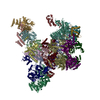 7pmnC C: citing same article ( M: map data used to model this data |
|---|---|
| Similar structure data |
- Links
Links
- Assembly
Assembly
| Deposited unit | 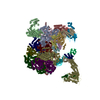
|
|---|---|
| 1 |
|
- Components
Components
-DNA replication licensing factor ... , 6 types, 6 molecules 234567
| #1: Protein | Mass: 102034.102 Da / Num. of mol.: 1 Source method: isolated from a genetically manipulated source Source: (gene. exp.)  Homo sapiens (human) / Gene: MCM2, BM28, CCNL1, CDCL1, KIAA0030 / Production host: Homo sapiens (human) / Gene: MCM2, BM28, CCNL1, CDCL1, KIAA0030 / Production host:  Trichoplusia ni (cabbage looper) / References: UniProt: P49736, DNA helicase Trichoplusia ni (cabbage looper) / References: UniProt: P49736, DNA helicase |
|---|---|
| #2: Protein | Mass: 91110.852 Da / Num. of mol.: 1 Source method: isolated from a genetically manipulated source Source: (gene. exp.)  Homo sapiens (human) / Gene: MCM3 / Production host: Homo sapiens (human) / Gene: MCM3 / Production host:  Trichoplusia ni (cabbage looper) / References: UniProt: P25205, DNA helicase Trichoplusia ni (cabbage looper) / References: UniProt: P25205, DNA helicase |
| #3: Protein | Mass: 96684.852 Da / Num. of mol.: 1 Source method: isolated from a genetically manipulated source Source: (gene. exp.)  Homo sapiens (human) / Gene: MCM4, CDC21 / Production host: Homo sapiens (human) / Gene: MCM4, CDC21 / Production host:  Trichoplusia ni (cabbage looper) / References: UniProt: P33991, DNA helicase Trichoplusia ni (cabbage looper) / References: UniProt: P33991, DNA helicase |
| #4: Protein | Mass: 82406.633 Da / Num. of mol.: 1 Source method: isolated from a genetically manipulated source Source: (gene. exp.)  Homo sapiens (human) / Gene: MCM5, CDC46 / Production host: Homo sapiens (human) / Gene: MCM5, CDC46 / Production host:  Trichoplusia ni (cabbage looper) / References: UniProt: P33992, DNA helicase Trichoplusia ni (cabbage looper) / References: UniProt: P33992, DNA helicase |
| #5: Protein | Mass: 93010.273 Da / Num. of mol.: 1 Source method: isolated from a genetically manipulated source Source: (gene. exp.)  Homo sapiens (human) / Gene: MCM6 / Production host: Homo sapiens (human) / Gene: MCM6 / Production host:  Trichoplusia ni (cabbage looper) / References: UniProt: Q14566, DNA helicase Trichoplusia ni (cabbage looper) / References: UniProt: Q14566, DNA helicase |
| #6: Protein | Mass: 81411.875 Da / Num. of mol.: 1 Source method: isolated from a genetically manipulated source Source: (gene. exp.)  Homo sapiens (human) / Gene: MCM7, CDC47, MCM2 / Production host: Homo sapiens (human) / Gene: MCM7, CDC47, MCM2 / Production host:  Trichoplusia ni (cabbage looper) / References: UniProt: P33993, DNA helicase Trichoplusia ni (cabbage looper) / References: UniProt: P33993, DNA helicase |
-DNA polymerase epsilon ... , 2 types, 2 molecules AB
| #7: Protein | Mass: 59600.887 Da / Num. of mol.: 1 Source method: isolated from a genetically manipulated source Source: (gene. exp.)  Homo sapiens (human) / Gene: POLE2, DPE2 / Production host: Homo sapiens (human) / Gene: POLE2, DPE2 / Production host:  Trichoplusia ni (cabbage looper) / References: UniProt: P56282 Trichoplusia ni (cabbage looper) / References: UniProt: P56282 |
|---|---|
| #8: Protein | Mass: 261855.266 Da / Num. of mol.: 1 Source method: isolated from a genetically manipulated source Source: (gene. exp.)  Homo sapiens (human) / Gene: POLE, POLE1 / Production host: Homo sapiens (human) / Gene: POLE, POLE1 / Production host:  Trichoplusia ni (cabbage looper) Trichoplusia ni (cabbage looper)References: UniProt: Q07864, DNA-directed DNA polymerase, Hydrolases; Acting on ester bonds; Exodeoxyribonucleases producing 5'-phosphomonoesters |
-Protein , 10 types, 12 molecules CHIJKLOPQRST
| #9: Protein | Mass: 66016.891 Da / Num. of mol.: 1 Source method: isolated from a genetically manipulated source Source: (gene. exp.)  Homo sapiens (human) / Gene: CDC45, CDC45L, CDC45L2, UNQ374/PRO710 / Production host: Homo sapiens (human) / Gene: CDC45, CDC45L, CDC45L2, UNQ374/PRO710 / Production host:  Trichoplusia ni (cabbage looper) / References: UniProt: O75419 Trichoplusia ni (cabbage looper) / References: UniProt: O75419 | ||||||||||||||||
|---|---|---|---|---|---|---|---|---|---|---|---|---|---|---|---|---|---|
| #14: Protein | Mass: 130098.148 Da / Num. of mol.: 3 Source method: isolated from a genetically manipulated source Source: (gene. exp.)  Homo sapiens (human) / Gene: WDHD1, AND1 / Production host: Homo sapiens (human) / Gene: WDHD1, AND1 / Production host:  Trichoplusia ni (cabbage looper) / References: UniProt: O75717 Trichoplusia ni (cabbage looper) / References: UniProt: O75717#15: Protein | | Mass: 138903.031 Da / Num. of mol.: 1 Source method: isolated from a genetically manipulated source Source: (gene. exp.)  Homo sapiens (human) / Gene: TIMELESS, TIM, TIM1, TIMELESS1 / Production host: Homo sapiens (human) / Gene: TIMELESS, TIM, TIM1, TIMELESS1 / Production host:  Trichoplusia ni (cabbage looper) / References: UniProt: Q9UNS1 Trichoplusia ni (cabbage looper) / References: UniProt: Q9UNS1#16: Protein | | Mass: 34600.223 Da / Num. of mol.: 1 Source method: isolated from a genetically manipulated source Source: (gene. exp.)  Homo sapiens (human) / Gene: TIPIN / Production host: Homo sapiens (human) / Gene: TIPIN / Production host:  Trichoplusia ni (cabbage looper) / References: UniProt: Q9BVW5 Trichoplusia ni (cabbage looper) / References: UniProt: Q9BVW5#19: Protein | | Mass: 46789.648 Da / Num. of mol.: 1 Source method: isolated from a genetically manipulated source Source: (gene. exp.)  Homo sapiens (human) / Gene: LRR1, PPIL5 / Production host: Homo sapiens (human) / Gene: LRR1, PPIL5 / Production host:  Trichoplusia ni (cabbage looper) / References: UniProt: Q96L50 Trichoplusia ni (cabbage looper) / References: UniProt: Q96L50#20: Protein | | Mass: 13147.781 Da / Num. of mol.: 1 Source method: isolated from a genetically manipulated source Source: (gene. exp.)  Homo sapiens (human) / Gene: ELOB, TCEB2 / Production host: Homo sapiens (human) / Gene: ELOB, TCEB2 / Production host:  Trichoplusia ni (cabbage looper) / References: UniProt: Q15370 Trichoplusia ni (cabbage looper) / References: UniProt: Q15370#21: Protein | | Mass: 155184.703 Da / Num. of mol.: 1 Source method: isolated from a genetically manipulated source Source: (gene. exp.)  Homo sapiens (human) / Gene: CLSPN / Production host: Homo sapiens (human) / Gene: CLSPN / Production host:  Trichoplusia ni (cabbage looper) / References: UniProt: Q9HAW4 Trichoplusia ni (cabbage looper) / References: UniProt: Q9HAW4#22: Protein | | Mass: 12485.135 Da / Num. of mol.: 1 Source method: isolated from a genetically manipulated source Source: (gene. exp.)  Homo sapiens (human) / Gene: ELOC, TCEB1 / Production host: Homo sapiens (human) / Gene: ELOC, TCEB1 / Production host:  Trichoplusia ni (cabbage looper) / References: UniProt: Q15369 Trichoplusia ni (cabbage looper) / References: UniProt: Q15369#23: Protein | | Mass: 87098.930 Da / Num. of mol.: 1 Source method: isolated from a genetically manipulated source Source: (gene. exp.)  Homo sapiens (human) / Gene: CUL2 / Production host: Homo sapiens (human) / Gene: CUL2 / Production host:  Trichoplusia ni (cabbage looper) / References: UniProt: Q13617 Trichoplusia ni (cabbage looper) / References: UniProt: Q13617#24: Protein | | Mass: 12289.977 Da / Num. of mol.: 1 Source method: isolated from a genetically manipulated source Source: (gene. exp.)  Homo sapiens (human) / Gene: RBX1, RNF75, ROC1 / Production host: Homo sapiens (human) / Gene: RBX1, RNF75, ROC1 / Production host:  Trichoplusia ni (cabbage looper) Trichoplusia ni (cabbage looper)References: UniProt: P62877, RING-type E3 ubiquitin transferase, cullin-RING-type E3 NEDD8 transferase |
-DNA replication complex GINS protein ... , 4 types, 4 molecules DEFG
| #10: Protein | Mass: 23022.469 Da / Num. of mol.: 1 Source method: isolated from a genetically manipulated source Source: (gene. exp.)  Homo sapiens (human) / Gene: GINS1, KIAA0186, PSF1 / Production host: Homo sapiens (human) / Gene: GINS1, KIAA0186, PSF1 / Production host:  Trichoplusia ni (cabbage looper) / References: UniProt: Q14691 Trichoplusia ni (cabbage looper) / References: UniProt: Q14691 |
|---|---|
| #11: Protein | Mass: 21453.713 Da / Num. of mol.: 1 Source method: isolated from a genetically manipulated source Source: (gene. exp.)  Homo sapiens (human) / Gene: GINS2, PSF2, CGI-122, DC5, HSPC037 / Production host: Homo sapiens (human) / Gene: GINS2, PSF2, CGI-122, DC5, HSPC037 / Production host:  Trichoplusia ni (cabbage looper) / References: UniProt: Q9Y248 Trichoplusia ni (cabbage looper) / References: UniProt: Q9Y248 |
| #12: Protein | Mass: 24562.611 Da / Num. of mol.: 1 Source method: isolated from a genetically manipulated source Source: (gene. exp.)  Homo sapiens (human) / Gene: GINS3, PSF3 / Production host: Homo sapiens (human) / Gene: GINS3, PSF3 / Production host:  Trichoplusia ni (cabbage looper) / References: UniProt: Q9BRX5 Trichoplusia ni (cabbage looper) / References: UniProt: Q9BRX5 |
| #13: Protein | Mass: 30114.236 Da / Num. of mol.: 1 Source method: isolated from a genetically manipulated source Source: (gene. exp.)  Homo sapiens (human) / Gene: GINS4, SLD5 / Production host: Homo sapiens (human) / Gene: GINS4, SLD5 / Production host:  Trichoplusia ni (cabbage looper) / References: UniProt: Q9BRT9 Trichoplusia ni (cabbage looper) / References: UniProt: Q9BRT9 |
-DNA chain , 2 types, 2 molecules MN
| #17: DNA chain | Mass: 26396.836 Da / Num. of mol.: 1 / Source method: obtained synthetically / Source: (synth.)  Homo sapiens (human) Homo sapiens (human) |
|---|---|
| #18: DNA chain | Mass: 12279.929 Da / Num. of mol.: 1 / Source method: obtained synthetically / Source: (synth.)  Homo sapiens (human) Homo sapiens (human) |
-Non-polymers , 4 types, 15 molecules 

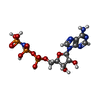
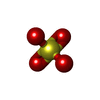



| #25: Chemical | ChemComp-ZN / #26: Chemical | #27: Chemical | #28: Chemical | ChemComp-SO4 / | |
|---|
-Details
| Has ligand of interest | Y |
|---|
-Experimental details
-Experiment
| Experiment | Method: ELECTRON MICROSCOPY |
|---|---|
| EM experiment | Aggregation state: PARTICLE / 3D reconstruction method: single particle reconstruction |
- Sample preparation
Sample preparation
| Component | Name: Human replisome engaged with CUL2-LRR1 / Type: COMPLEX / Entity ID: #21, #1-#20, #22-#24 / Source: MULTIPLE SOURCES |
|---|---|
| Molecular weight | Experimental value: NO |
| Source (natural) | Organism:  Homo sapiens (human) Homo sapiens (human) |
| Source (recombinant) | Organism:  Trichoplusia ni (cabbage looper) Trichoplusia ni (cabbage looper) |
| Buffer solution | pH: 7.6 |
| Specimen | Embedding applied: NO / Shadowing applied: NO / Staining applied: NO / Vitrification applied: YES |
| Specimen support | Grid material: COPPER / Grid mesh size: 400 divisions/in. / Grid type: Quantifoil R2/2 |
| Vitrification | Cryogen name: ETHANE |
- Electron microscopy imaging
Electron microscopy imaging
| Experimental equipment |  Model: Titan Krios / Image courtesy: FEI Company |
|---|---|
| Microscopy | Model: FEI TITAN KRIOS |
| Electron gun | Electron source:  FIELD EMISSION GUN / Accelerating voltage: 300 kV / Illumination mode: FLOOD BEAM FIELD EMISSION GUN / Accelerating voltage: 300 kV / Illumination mode: FLOOD BEAM |
| Electron lens | Mode: BRIGHT FIELD / Nominal defocus max: 2800 nm / Nominal defocus min: 800 nm / Cs: 0.1 mm / C2 aperture diameter: 2.7 µm |
| Specimen holder | Specimen holder model: FEI TITAN KRIOS AUTOGRID HOLDER |
| Image recording | Average exposure time: 4 sec. / Electron dose: 38.8 e/Å2 / Film or detector model: GATAN K3 BIOQUANTUM (6k x 4k) / Num. of real images: 16721 |
| EM imaging optics | Energyfilter name: GIF Bioquantum / Energyfilter slit width: 20 eV |
- Processing
Processing
| EM software |
| ||||||||||||||||||||||||
|---|---|---|---|---|---|---|---|---|---|---|---|---|---|---|---|---|---|---|---|---|---|---|---|---|---|
| CTF correction | Type: PHASE FLIPPING AND AMPLITUDE CORRECTION | ||||||||||||||||||||||||
| Particle selection | Num. of particles selected: 2412000 | ||||||||||||||||||||||||
| 3D reconstruction | Resolution: 2.8 Å / Resolution method: FSC 0.143 CUT-OFF / Num. of particles: 232000 / Algorithm: FOURIER SPACE / Num. of class averages: 1 / Symmetry type: POINT |
 Movie
Movie Controller
Controller





















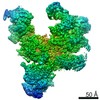





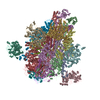

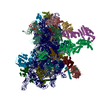

 PDBj
PDBj